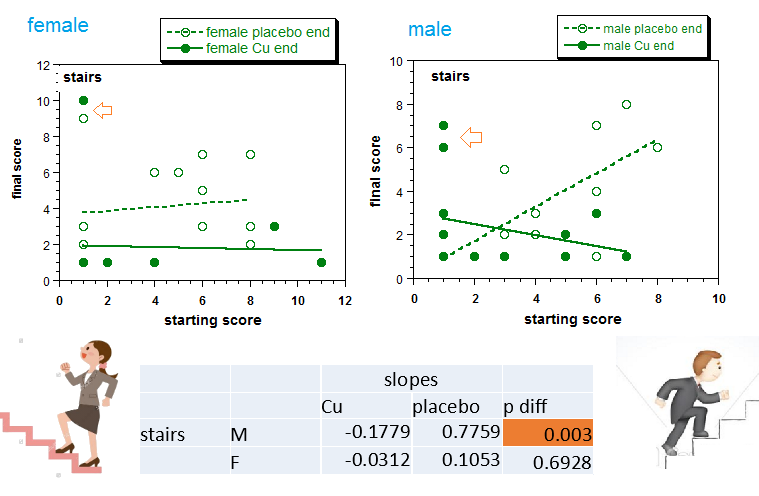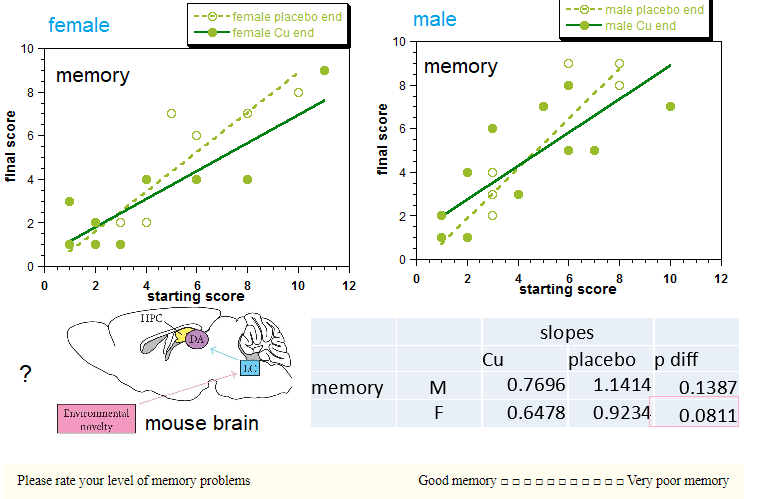2021 Update
This post was originally published in May of 2020 with password protection. We have since published these results on clinicaltrials.gov. While these data have not been peer reviewed for mechanisms of action and so forth, they have undergone rigorous examination by clinicaltrials.gov for consistency and the general safety measures. We’d like to thank KGK Synergize for assisting us in reexamining the data with a linear regression model. This “SIQR” questionnaire proved to be valuable . The limitations of small sample sizes when it come to making medical claims will be apparent. We encourage you to show your physician these data and ask if they think you should try CopperOne. If nothing else, it is safe.
KGK Synergize “The SIQR is a variant of the Revised Fibromyalgia Impact Questionnaire (FIQR)[1] used to assess the overall impact and severity of a disease condition on one’s life. The SIQR is divided into 3 domains which includes sections on: 1) the effect of the medical condition on the participant’s ability to perform daily activities; 2) the overall impact of the participant’s medical problems; and 3) the intensity of symptoms (pain, fatigue, tenderness, sleep, etc.) [1]. For this questionnaire, lower scores means less symptoms and consequently better health.”
“Cunermuspir (Cu(I)NA2) outperformed placebo in the total SIQR score, all of the SIQR subscores and the stiffness scale at day 28, as revealed by the ANCOVA analyses. Although not significant, Cunermuspir supplementation also showed a trend towards a significantly better pain score as compared to placebo (p=0.08).”
“Significant within group reductions for each SIQR subscore were seen with Cunermuspir supplementation. In fact, 40% reductions in the total SIQR score and 51%, 65% and 29% reductions in function, overall impact of medical problems and symptoms intensity subscores, respectively were seen with Cunermuspir supplementation, as compared to only 9%, 33% and 14% decreases in the placebo group. Statistical analyses of the individual rating scales revealed significant reductions of 34% and 35% from baseline in the pain and stiffness scores with Cunermuspir supplementation.”
Unlike the INQoL questions, SIQR were short and explicit. Some research on copper and blood flow to muscles inspired a new way of analyzing the data that was performed with the help of a statistician from KGK Synergize. It is the secondary outcome measures that saved theday.
- Final scores on each question were plotted as a function of the starting score.
- Statstodoc was used to compare the regressions of the two lines: Placebo Group and Cu Group.
- Males and Females were split in the analyses of these data. As the whimsical cartoons will illustrate, these questions have gender bias.
Hypothetical data

If everyone in the study finished the study with the same score as they started it, the slope would be 1.0. If participants started with a wide range of symptom impact but finished the study with a “almost no impact” score of 0, the slope would be very close to 0.
Difficulties with tasks requiring muscles
The SIQR questionnaire contains many gender bias questions. Cartoons are added to get the reader to really think about how males and females may perform a task differently. When significant differences are observed, we gain insight on how may be acting that is Cu(I)NA2 acting on NMDA receptors.
Discomfort while sitting
One of the SIQR questions asked if there was discomfort while sitting in a chair for more than 45 minutes. These cartoons remind us that males and females tend to sit differently in chairs.

A slope of 0.866 (dashed line) as well as a Y-axis intercept close to zero indicates that for women in the placebo group had the same issues with chair sitting at the end of the study as they did at the beginning. A slope of -0.0608 suggests a partial but incomplete “cure” While four of the females finished the study with a score of “1”, almost no problem, others still had minor discomfort with prolonged chair sitting.
Discomfort while combing hair
Females tend to have more hair and more elaborate hair styles. Note that hair combing requires use of the trapezius muscle and raising one’s hand above the head

Note that the females in the copper group started the study with no problem combing her hair (score of 1) or major problems (score of 10). At the end of the study, no female in the copper group had trouble combing her hair.
Difficulty lifting grocery bags
This question may be interpreted in many ways. Does lifting grocery bags from the ground or from the check out counter? Either way, the trapezius muscle may be involved for the males and females.

These data are nice because both the Cu(I)NA2 and the placebo groups, males and females, started the study with a wide range of scores. The probability that the slopes of these regression lines are different (p diff) is highly significant for both males (p=0.011) and females (p = 0.0043).
Difficulty changing bed sheets
This study lasted only 28 days during the winter, in Canada. In this case we have both gender and seasonal bias. Do males in the winter, in Canada or cold parts of the rest of the world even wash and change sheets more than once a month?

Unfortunately only one of the females in the Cu(I)NA2 group started the study with troubles folding sheets. She was “cured”. While the improvement may be significant at p=0.007, we cannot conclude any based on one individual. These results are promising and point to a theme of increased upper body muscle function.
Discomfort while vacuuming
Vacuuming would seem to be an upper body , particularly back intensive activity. The highly significant difference in slopes between the placebo and Cu(I)NA2 groups of women is due to one woman who had massive problems and was almost “cured” along with a bunch in the placebo group that more or less remained the same. The male Cu(I)NA2 group would have fared much better statistically were it not for one male who started out with a score of 9 and only improved to a 8. Overall, the Cu(I)NA2 seems to help.

Discomfort or difficulty climbing stairs
All three of the women on Cu(I)NA2 who started the study with stair climbing issues had a final score of 1, no difficulty. . Many of the women in the placebo group who started the study with stair climbing issues ended the study less impaired. The men were a different situation. Note that there were two men on Cu(I)NA2 that started the study with no stair climbing issues ended the study with moderate issues with stair climbing. And the usual caveats of a small study group

Orange arrows point to the participant who started out with no stair climbing discomfort that developed problems at the end of the study.
Discomfort or difficulty walking more than 20 minutes
No statistical differences between Cu(I)NA2 and placebo groups was seen. There is some hint that Cu(I)NA2 improved the ability to walk for long period of time in women more severely compromised at the start. The emerging trend is that Cu(I)NA2 improves activities involving upper body muscles. However, this walking animation suggests waking involves considerable should motion.

Difficulties with emotional aspects of life
Anxiety
No significance between Cu(I)NA2 and the placebo was seen in the SIQR parameter. Many amine oxidases use copper as a co factor. This may be addressed in a later post.
Depression
No significance between Cu(I)NA2 and the placebo was seen in the SIQR parameter. Many amine oxidases use copper as a co factor. This may be addressed in a later post.
Energy
No significance between Cu(I)NA2 and the pacebo was seen in the SIQR parameter. Unfortunately, the SIQR did not give a rigorous definition of energy. Energy could mean emotional motivation to do work or physical ability to do work. And if the latter, physical work involving which muscle groups?
Cooking a home cooked meal…
No significance between Cu(I)NA2 and the placebo was seen in the SIQR parameter. Aside from the gender bias, cooking a home cooked meal has emotional aspects of planning and execution as well as the prolonged periods of standing and upper body motions of hands, arms, and shoulders.
Goals
Does my medical condition prevent me from reaching my goals? The data (not shown) suggest an empowering affect of participating in a clinical trial. No significance between Cu(I)NA2 and the placebo was seen in the SIQR
Overwhelmed
Are you overwhelmed by your neuromuscular problem? This one seems to be mostly psychological. There is no improvement in the Cu(I)NA2 groups relative to the placebo groups. Judging by the slopes of the lines, there is a placebo affect. Perhaps just being in a clinical trial empowered some of the participants.
Other discomforts that easily classified
Memory
All of the slopes of these regressions are close to 1.0 indicating no change in the status.

While there is slight indication that improved memory in female participants in this regression model, it does not meet the threshold of p<0.05 level of significance. The role of the copper rich locus ceruleus in acquiring novel memories in mice might be addressed in a later post [2]. We cannot even speculate in this small study group. Future work might hone in on questions that address the role of the locus ceruleus in acquiring novel memories.
Sleep
It is beyond the scope of this post to get into the locus ceruleus, copper contianing enzyme dopamine beta-hydroxylase that cleaves dopamine to norepinephrine, and circadian rhythms. It is worth remembering that this clinical trial was conducted during a Canadian winter. Were these participants experiencing seasonal affective disorder?

The males in the Cu(I)NA2 group more or less stayed the same. The males in the placebo group seem to have gotten a little worse. Mitosynergy considers these results interesting but inconclusive. This could be an avenue of future study once we have a better understanding of sopper in the locus ceruleus and circadian rhythms,
Tenderness
Tenderness may be defined as increased pain threshold upon touching. There is a significance difference (p=0.0415) in the slopes of Cu(I) and placebo groups of women but not men. Perhaps this has to do with inflamed fascia, the sacks that muscle fibers reside in along with nerves. There could be a relationship with hair combing.

Stiffness
Stiffness was not influenced by Cu(I)NA2 treatment in men or women. The survey question did not specify the site of muscle stiffness. ATP is required for skeletal muscle to relax. When an animal dies, ATP production stops. Myosin is bond to actin in what are called rigor cross bridges. They were named after rigor mortis. Stiffness could also be due to failure to secure calcium back into the sacroplasmic reticulum or continued muscle stimulation. Which ever mechanism, Cu(I)NA2 had no influence (data not shown)
Balance
No significance between Cu(I)NA2 and the placebo was seen in the SIQR parameter. Copper deficiency has been reported as a cause of treatable poor balance in an elderly man [4].
References
- Bennett RM, Friend R, Jones KD, Ward R, Han BK, Ross RL.(2009)The Revised Fibromyalgia Impact Questionnaire (FIQR): validation and psychometric properties. Arthritis Res Ther. 2009;11(4):R120. [PMC free article]
- Yamasaki M, Takeuchi T (2017) Locus Coeruleus and Dopamine-Dependent Memory Consolidation. Neural Plast. 2017;2017:8602690. [PMC free article]
- Xiao T, Ackerman CM, Carroll EC, Jia S, Hoagland A, Chan J, Thai B, Liu CS, Isacoff EY, Chang CJ. (2018)Copper regulates rest-activity cycles through the locus coeruleus-norepinephrine system. Nat Chem Biol. 2018 Jul;14(7):655-663. [PMC free article]
- Khaleeli Z, Healy DG, Briddon A, Lunn MP, Reilly MM, Land J, Giovannoni G.(2010)Copper deficiency as a treatable cause of poor balance. BMJ. 2010 Apr 12;340:c508. doi: 10.1136/bmj.c508.

One thought on “Symptom Impact Questionnaire Revised”